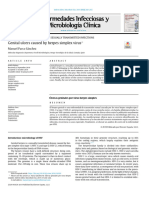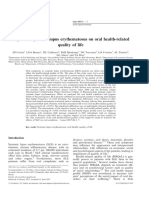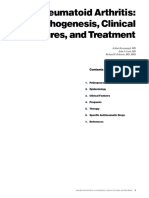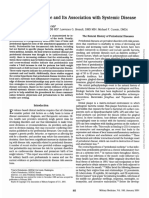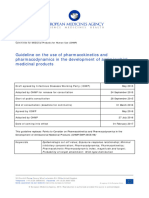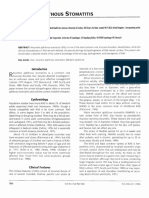The Pathogenesis of Psoriasis: Insight Into A Complex "Mobius Loop" Regulation Process
The Pathogenesis of Psoriasis: Insight Into A Complex "Mobius Loop" Regulation Process
Uploaded by
gugicevdzoceCopyright:
Available Formats
The Pathogenesis of Psoriasis: Insight Into A Complex "Mobius Loop" Regulation Process
The Pathogenesis of Psoriasis: Insight Into A Complex "Mobius Loop" Regulation Process
Uploaded by
gugicevdzoceOriginal Title
Copyright
Available Formats
Share this document
Did you find this document useful?
Is this content inappropriate?
Copyright:
Available Formats
The Pathogenesis of Psoriasis: Insight Into A Complex "Mobius Loop" Regulation Process
The Pathogenesis of Psoriasis: Insight Into A Complex "Mobius Loop" Regulation Process
Uploaded by
gugicevdzoceCopyright:
Available Formats
Review Article More Information
*Address for Correspondence: Jingrong Lin,
The pathogenesis of psoriasis: Department of Dermatology, The First Affiliated
Hospital of Dalian Medical University, No. 222,
Zhongshan Road, Dalian 116011, China,
insight into a complex “Mobius Email: amy4963@163.com
ORCiD: orcid.org/0000-0002-4737-0856
Loop” regulation process Jialin Qu, Laboratory of Integrative Medicine,
The First Affiliated Hospital of Dalian Medical
Yuankuan Jiang1,2,4#, Haiyang Chen2-4#, Jiayue Liu2-4, Tianfu University; No. 222, Zhongshan Road, Dalian
116011, China, Email: jialin_qu@126.com
Wei2-4, Peng Ge2-4, Jialin Qu4* and Jingrong Lin1*
ORCiD: orcid.org/0000-0001-6064-5001
1
Department of Dermatology, The First Affiliated Hospital of Dalian Medical University, No. 222, Submitted: October 14, 2021
Zhongshan Road, Dalian 116011, China Approved: October 21, 2021
Published: October 22, 2021
2
Institute (College) of Integrative Medicine, Dalian Medical University, No. 9, South Road of Lvshun,
Dalian 116044, China How to cite this article: Jiang Y, Chen JH, Liu J,
3
Department of General Surgery, Pancreatic-Biliary Center, The First Affiliated Hospital of Dalian Wei T, Ge P, et al. The pathogenesis of psoriasis:
insight into a complex “Mobius Loop” regulation
Medical University, No. 222, Zhongshan Road, Dalian 116011, China
process. Arch Pathol Clin Res. 2021; 5: 020-025.
4
Laboratory of Integrative Medicine, The First Affiliated Hospital of Dalian Medical University, No. 222,
Zhongshan Road, Dalian 116011, China DOI: 10.29328/journal.apcr.1001024
#
Yuankuan Jiang and Haiyang Chen contributed equally to this work Copyright: © 2021 Jiang Y, et al. This is an open
access article distributed under the Creative
Commons Attribution License, which permits
unrestricted use, distribution, and reproduction
Abstract in any medium, provided the original work is
properly cited.
Psoriasis is a chronic inflammatory skin disease with a complex mechanism, which is believed
to be mainly based on immune disorders and activation of inflammatory pathways. However, we Keywords: Psoriasis; Pathogenesis; Mobius loop
have combed through the literature and found that the pathogenesis of psoriasis might involve a Abbreviations: FDA: Food and Drug
“mobius loop” of “immunity-inflammation-oxidative stress-proliferation” process. The disordered Administration; KC: Keratinocytes; AMPs:
immune environment of the skin might act as the basis, the outbreak of inflammatory factors as the Antimicrobial Peptides; DC: Dendritic Cells; pDC:
mediator, and the imbalance of oxidative stress homeostasis as the activator. These factors work Plasma cell-like Dendritic Cells; NF-kb: Nuclear
together, leading to abnormal proliferation of keratinocytes and further immune abnormalities, Factor Kappa-B; IL: Interleukin; TLR: Toll-
finally aggravating psoriasis. Therefore, here we review the latest evidence and advance in the Like Receptor; IFN: Interferon; MDC: Myeloid
pathogenesis of psoriasis, trying to contribute to further understanding and treatment of psoriasis. Dendritic Cells; TNF: Tumor Necrosis Factor;
CD4+T: Cluster of Differentiation 4: CD8+T:
Cluster of Differentiation 8; Th: T Helper Cell;
Introduction ERK: Extracellular Signal-Regulated Kinase;
TAK1: TGF-Β Activated Kinase 1; IKK: I-kb
Psoriasis is a chronic in lammatory skin disease with Kinase; AP-1: Activator Protein-1; ROS: Reactive
Oxygen Species; CCL20: Chemokine (C-C
a complex mechanism associated with genetic factors and Motif) Ligand 20; mTOR: Mammalian Target Of
immune reactions. Although the global prevalence rate is Rapamycin; EGFR: Epidermal Growth Factor
about 2%, certain geographical differences are noticed. Receptor; TGF-α: Transforming Growth Factor Α;
DcR3: Decoy Receptor 3
The incidence rate is low in Asia and some African regions,
reaching 11% in Northern Europe and Caucasians [1-3]. At
present, a radical cure of psoriasis is still unavailable, and OPEN ACCESS
there are nearly 6 million patients in China whose condition
has not been effectively controlled [4]. In recent years, in-
depth studies on the mechanism of psoriasis have pointed secukinumab, Ixekizumab and Brodalumab, and put into
out new directions, providing new targets and strategies for clinical practice successively in the past ive years [5-7].
further treatment of the disease. Therefore, this article reviews the latest advances in the
pathogenesis of psoriasis to provide a theoretical basis for
In terms of modern medicine, in addition to the classical treatment and drug selection of the disease.
small-molecule drugs such as acitretin, methotrexate and
The latest progress in the pathogenesis of psoriasis
cyclosporine, novel agents including apremilast and dimethyl
fumarate have also been put into clinical application. In Psoriasis is characterized by in lammatory in iltration,
particular, the FDA approved biological agents such as angiogenesis as well as abnormal proliferation and
https://doi.org/10.29328/journal.apcr.1001024 www.pathologyresjournal.com 020
The pathogenesis of psoriasis: insight into a complex “Mobius Loop” regulation process
differentiation of keratinocytes. The pathogenesis is changes may also trigger abnormal proliferation of kera-
complicated. With the enrichment of genetics-immune- tinocytes and the release of in lammatory factors by activating
in lammation theory, more and more attention has been target genes. The epigenetic mechanism in psoriasis mainly
addressed to the loop regulation of oxidative stress and involves microRNA and methylation modi ication. On the
abnormal proliferation and differentiation of keratinocytes. one hand, studies on miRNA had revealed that miR-21,
We believed that the pathogenesis of psoriasis underwent miR-31, miR-135b, miR-222 and miR-424 could induce
the following three critical stages [8-10]. the proliferation and differentiation of keratinocytes by
promoting NF-κB activity [16-18]. Similarly, miR-203 could
Under the background of genetic defects or abnormal aggravate in lammation by enhancing transmembrane
modi ications, inappropriate immune response provokes conduction via stimulating STAT3 signal, miR-210 could
in lammatory reactions. aggravate immune disorders by promoting the Th1 and Th17
The in lammatory reactions are ampli ied in a cascade differentiation through regulating T cell polarity [19-21].
leading to a cytokine storm and then aggravated the On the other hand, methylation modi ication of genes may
imbalanced oxidative stress homeostasis. cause immune disorders by activating autoimmunity [22].
A clinical study found that the methylation level of m6A (an
Uncontrolled keratinocytes proliferation and dysfun- important anti-in lammatory factor that maintains immune
ctional differentiation are caused by in lammation. The homeostasis) in psoriatic lesions was signi icantly decreased
proliferated keratinocytes participate in the vicious circle compared with normal skin. At the same time, S100A9, which
of “immune-in lammation-oxidative stress-proliferation- promotes cell proliferation and differentiation, was increased
immune” leading to exacerbation and progression of psoriasis. explosively [23-25].
In this section, we will elaborate on the above vital stages The activation of genetic factors provides the incentive
respectively (Figure 1). for the next immune disorder, while a series of activation of
micRNA aggravates the in lammatory response and provides
Genetic and epigenetics factors the basis for the pathological development of psoriasis.
In recent years, the role of genetic factors in the Therefore, although the genetic factors do not serve as
pathogenesis of psoriasis has attracted increasing attention. independent pathogenic factors of psoriasis, they contribute
A genome-wide study found that at least 60 chromosomal to the immune-in lammation-proliferation process as an
genes, including the PSORS1 gene, are susceptible sites for essential risk and additional factor.
psoriasis [11,12]. The CARD14 locus, which constitutes the Disorders in innate immunity and autoimmune response
NF-κB scaffold protein, is mapped onto the PSORS1. The
mutation at the CARD14 locus will cause abnormal activation The latest genome-wide association studies revealed that
of NF-κB and further amplify the in lammation in skin lesions the disorders in innate immunity and autoimmune response
[13]. In addition, IL-23, as a dimer structure composed of are the major factors that induce the development of
P40 and P19, has also exhibited multiple crossovers in the psoriasis and maintain the in lammatory environment [26].
Previous studies suggested that the prosiatic keratinocytes
immune response of psoriasis. The corresponding IL-23R
secret a series of antimicrobial peptides (AMPs), among
is also considered a high-risk gene for the development of
which LL37 has attracted more attention. The LL37 released
psoriasis [14,15].
by keratinocytes binds with DNA and RNA, respectively,
In addition to alterations of genetic sequence such as forming a complex that binds with the toll-like receptor 9
mutations and dislocations of susceptible genes, epigenetic (TLR9) and TLR7 on the plasmacytoid dendritic cells (pDC),
and stimulates the pDCs to secrete type I interferons (IFN-α
and IFN-β) [27,28]. The secreted interferons will promote
the maturation and differentiation of myeloid dendritic cells
(mDC), Th1 and Th17 cells, and further accelerate cytokine
secretion such as IFN-γ and IL-17 [29-31]. After maturation
and activation, mDCs migrate to the lymph nodes and secrete
tumor necrosis factor (TNF)-α, IL-23 and IL-12, promoting
the proliferation and differentiation of Th17 and Th1 cells.
TNF-α and IL-23 activate the innate immune process by
stimulating T cell subsets mainly composed of Th17 cells,
thus maintain the in lammatory level of psoriatic lesions.
In the meantime, the cytokines (IL-17, IL-21 and IL-22)
secreted by T cells signi icantly promote the proliferation of
Figure 1: The Mechanism of “Mobius Loop” in Psoriasis.
keratinocytes [32]. Besides the activation of innate immunity,
https://doi.org/10.29328/journal.apcr.1001024 www.pathologyresjournal.com 021
The pathogenesis of psoriasis: insight into a complex “Mobius Loop” regulation process
LL37 also acts as the autoantigen of T cells to initiate its activated but insuf icient to counterweigh the high levels of
autoimmune process. After LL37 presentation, the speci ic in lammation and oxidation in psoriasis. 0Instead, it increases
CD4+T cells secrete large amounts of IL-17, IL-21, IL-22 and secretion of K6, K16 and K17, promotes proliferation and
IFN-γand aggravate the in lammatory reactions; the speci ic inhibits apoptosis of keratinocytes, playing a protective role
CD8+T cells are directly involved in epidermal growth, in hyperproliferative keratinocytes [44,45]. However, it is
angiogenesis, presentation and activation process of other noteworthy that ROS functions more as a tandem role in the
autoantigens such as keratin 17, and further promote the pathogenesis of psoriasis, which is initiated by abnormal
secretion of Th17-associated cytokines [33,34]. Therefore, immune environment and initiates the proliferation of
the disorders of innate immunity and autoimmune response keratinocytes through the metabolic.
are the basis of the pathophysiological changes in psoriasis.
Abnormal proliferation and differentiation of keratinocytes
Inflammatory response and cytokine storm centered
on the TNF-α–IL-23–Th17 pathway Previous studies have shown that keratinocytes participate
in the initial stage of a series of complex immune responses
As the immune environment changes, the pro- in psoriasis and act as the end effector cells that respond to
in lammatory molecules in the internal environment begin the immune reactions, undergoing hyperproliferation and
to express, inducing the in iltration of in lammatory cells, abnormal differentiation. After damage, the keratinocytes
and triggering the in lammatory cascade. The TNF-α–IL-23– play the role of self-protection by releasing AMPs. However,
TH17 pathway plays a central regulatory role in this process. in addition to the anti-infective effect of AMPs, they also
During the in lammatory cascade, TNF-α and IL-23 secreted activate the innate immunity, releasing large amounts of
by immune cells promote the maturation and differentiation IL-17, IL-26, IL-29 and TNF-α to amplify the in lammatory
of Th17 cells and secrete large amounts of IL-17. IL-17 is the reaction. In turn, the excessively released in lammatory
central effector molecule of psoriasis [35], with the IL-17A factors act directly on keratinocytes, activate CXCL9/10/11
exhibiting the strongest pro-in lammatory effect. A trimeric through the STAT1 pathway, and induce the Th1 cells to
receptor complex formed by two IL-17RA subunits and one IL- migrate into the epidermis [38,46].
17RC subunit could induce the recruitment of ACT1 adaptor
protein and activate a large number of intracellular kinases, In addition, keratinocytes can directly induce the
including extracellular signal-regulated kinase (ERK), p38 activation of CCL20 and CXCL1/2/3/5/8 after the release of
MAPK, TGF-β activated kinase 1(TAK1), and I-κB kinase (IKK) AMPs and promote the in iltration of immune cells such as
[36,37]. The abnormal activation of kinases will signi icantly neutrophils, macrophages and dendritic cells, facilitate the
activate transcription factors and chemokines such as NF-κB formation of Munro’s microabscess, and further promote
and AP-1, provoking a cytokine storm [38]. In addition to the the proliferation of keratinocytes to thicken the epidermis
regulatory mechanism of the TNF-α–IL-23–Th17 pathway, [38,47,48]. The existence of extensive parakeratotic cells
Th17 cells can also activate the STAT1 signaling pathway in the stratum corneum enables sustained activation of the
by secreting IL-26 and IL-29, and evoke a feedforward downstream regulatory mechanism of epidermal growth
in lammatory response along with NF-κB to maintain the factor receptor (EGFR), leading to further proliferation
level of in lammation in the internal environment [38,39]. and abnormal differentiation of keratinocytes [49]. With
During the in lammatory cascade, the in lammatory signal the increasing expression of EGFR, its ligand TGF-α is also
was magni ied successively, inally provoking a cytokine overexpressed [50]. The speci ic combination of TGF-α with
storm and recruiting many in lammatory cell in iltration EGFR could amplify the signal sensitivity of TNF-α and IFN-γ
to build a highly in lammatory extracellular environment to keratinocytes and aggravate the in lammatory reaction
and facilitate the abnormal proliferation and differentiation [51]. Meanwhile, sustained stimulation of high intensity by
through breaking the oxidative stress balance. TNF-α will reversely activate through the NF-κB pathway[
The imbalance of oxidative stress homeostasis 52], forming a loop regulation.
During the immune and in lammatory stages, neutrophils In addition, the sustained high level of EGFR also
in the blood proliferate massively and undergo oxidative participates in angiogenesis via stimulating the expression
burst by secreting large amounts of ROS under the of decoy receptor 3(DcR3/TR6) [53]. After NF-κB being
stimulation of TNF-α [40]. ROS acts directly on keratinocytes abundantly expressed in keratinocytes, the expression of its
and ibroblasts and causes a rapid decline in intracellular downstream proteins, including NLRP3, Pro-IL-1β and Pro-
Ca2+ concentration, which could shift the state of cells from IL-18 will also be accelerated. The precursors of the above
promoting differentiation to rapid proliferation [41,42]. It proteins will be modi ied and activated by the activated
has been reported that increased ROS could increase mTOR caspase-1, not only hasten the proliferation of adjacent
secretion, thus directly activate NF-κB and stimulate the keratinocytes by activating pyroptosis and releasing large
release of in lammatory cytokines[43]. With the accumulation amounts of in lammatory factors, but also increase the
of intracellular ROS, the intracellular antioxidant system was polarity of T cells, induce their differentiation into Th17,
https://doi.org/10.29328/journal.apcr.1001024 www.pathologyresjournal.com 022
The pathogenesis of psoriasis: insight into a complex “Mobius Loop” regulation process
and compel the keratinocytes into the vicious circle of In the keratinocytes of psoriasis, autophagy takes the
immunity-in lammation-oxidation-proliferation-immunity, initiative to clear the damaged cells and deceive the apoptosis
accelerating the progression of psoriasis[54-56]. monitoring system of the body when mitochondrial damage
occurs. In addition, follicular phagocytosis is the process
Conclusion and prospect of digesting cells and their contents by lysosomes, mostly
involving degradation at the protein level. Besides, the mRNA
It is widely known that the immune factor is undoubtedly
of accumulated in lammatory factors in damaged cells may
a dominant factor in the pathogenesis of psoriasis. The
diffuse to the external environment of keratinocytes through
inappropriate response to the immune system induces the
autophagy. Gene sequences in the functional domain may
in lammatory reaction, and the stepwise ampli ication of
directly act on membrane receptors to activate antigen-
the signal leads to a cytokine storm, which stimulates the
presentation, as at the protein level, and further stimulate
imbalance of oxidative stress homeostasis and aggravates
the proliferation and differentiation of keratinocytes [59,60].
the in lammatory response. The reinforced in lammatory
Therefore, drugs such as camptothecin, which can not only
reaction then acts on keratinocytes and dendritic cells,
inhibit cytokine storms, but also interfere with the autophagy
forming a closed-loop regulation. Keratinocytes play an
and apoptosis of keratinocytes, will become a new option
essential role in this loop. They are the end effector cells
for the treatment of psoriasis [61-63]. Thus, we speculate
of psoriasis undergoing hyperproliferation and abnormal
that induction of keratinocytes into normally programmed
differentiation under various in lammatory factors. The
apoptosis might also be an effective means of intervention in
beginning of the loop regulation provokes the acquired
addition to an essential feature of psoriasis.
immune pathway by releasing a series of antibacterial
peptides LL37 after keratinocytes damage. We speculate that Author contribution
this might be the underlying cause of Koebner’s phenomenon
YJ and HC conceived this review and drafted the
in psoriasis. Therefore, the regulation mechanism of
manuscript. JL and TW are responsible for the igure drawing
psoriasis is not a simple process of signal ampli ication step
and literature collation. PG and JL edited and inalized the
by step, but a complex “Mobius Ring” regulation process of
manuscript for submission. JL and JQ reviewed and approved
immunity-in lammation-oxidation-proliferation-immunity
the submitted manuscript.
by AMPs. Blocking the progress of this vicious circle has been
considered the ideal treatment for various molecular drugs, References
biological agents, prescriptions and monomers from Chinese 1. Rachakonda TD, Schupp XW, Armstrong AW. Psoriasis prevalence
medicine. Unfortunately, no immune-in lammatory reaction among adults in the United States. J Am Acad Dermatol. 2014; 70:
could occur independently of the whole immune regulatory 512-516.
PubMed: https://pubmed.ncbi.nlm.nih.gov/24388724/
system, and excessive inhibition of any target on the pathway
will interfere with other normal systems. For example, the 2. Christophers E. Psoriasis--epidemiology and clinical spectrum. Clin
Exp Dermatol. 2001; 26: 314-320.
application of biological agents speci ically targeting IL-17 PubMed: https://pubmed.ncbi.nlm.nih.gov/11422182/
will also affect the intestinal in lammatory environment and
3. Parisi R, Symmons DP, Griffiths CE, Ashcroft DM, Identification and
cause the destruction of the intestinal barrier [57]. Management of Psoriasis and Associated ComorbidiTy (IMPACT)
project team, et al. Global epidemiology of psoriasis: a systematic review
In the previous studies, keratinocytes were frequently of incidence and prevalence. J Invest Dermatol. 2013; 133: 377-385.
used as the research object to investigate proliferation and PubMed: https://pubmed.ncbi.nlm.nih.gov/23014338/
changes of the in lammatory environment. Our literature 4. Committee on Psoriasis, Chinese Society of Dermatology. Guideline
review has revealed that the role of keratinocytes in immune for the diagnosis and treatment of psoriasis in China 2018 simplified
edition) [J]. Chin J Dermatol. 2019; 52: 223-230.
regulation might be underestimated, and the keratinocytes
regulatory loop might be an important treatment target. 5. Gesser B, Johansen C, Rasmussen MK, Funding AT, Otkjaer K, et al.
Dimethylfumarate specifically inhibits the mitogen and stress-
First, keratinocytes essential speci icity as the essential activated kinases 1 and 2 (MSK1/2): possible role for its anti-psoriatic
cells of the skin. Targeting keratinocytes will not affect effect. J Invest Dermatol. 2007; 127: 2129-2137.
the immune homeostasis of other organs in the body. PubMed: https://pubmed.ncbi.nlm.nih.gov/17495961/
Second, the proliferation of keratinocytes is the primary 6. Lehmann JC, Listopad JJ, Rentzsch CU, Igney FH, von Bonin A, et al.
Dimethylfumarate induces immunosuppression via glutathione
clinical manifestation of psoriasis. Hyperproliferation of
depletion and subsequent induction of heme oxygenase 1. J Invest
keratinocytes could be induced by in iltration of in lammatory Dermatol. 2007; 127: 835-845.
factors and inhibition of their apoptosis as well. Autophagy PubMed: https://pubmed.ncbi.nlm.nih.gov/17235328/
is a well-recognized cytoprotective mechanism as opposed 7. Huang YW, Tsai TF. A drug safety evaluation of risankizumab for
to apoptosis. However, it may not simply play a protective psoriasis, Expert opinion on drug safety. 2020; 19: 395-402.
PubMed: https://pubmed.ncbi.nlm.nih.gov/32100591/
role in the proliferation and apoptosis of keratinocytes.
The ROS accumulation caused by hypoxia condition due to 8. Grän F, Kerstan A, Serfling E, Goebeler M, Muhammad K. Current
Developments in the Immunology of Psoriasis. Yale J Biol Med. 2020;
keratinocytes proliferation and the consequent mitochondrial 93: 97-110.
damage is a direct inducing factor for apoptosis [58]. PubMed: https://pubmed.ncbi.nlm.nih.gov/32226340/
https://doi.org/10.29328/journal.apcr.1001024 www.pathologyresjournal.com 023
The pathogenesis of psoriasis: insight into a complex “Mobius Loop” regulation process
9. Ni X, Lai Y. Keratinocyte: A trigger or an executor of psoriasis. J 25. Roberson ED, Liu Y, Ryan C, Joyce CE, Duan S, et al. A subset of
Leukoc Biol. 2020; 108: 485-491. methylated CpG sites differentiate psoriatic from normal skin. J Invest
PubMed: https://pubmed.ncbi.nlm.nih.gov/32170886/ Dermatol. 2012; 132: 583-592.
PubMed: https://pubmed.ncbi.nlm.nih.gov/22071477/
10. Christophers E, Metzler G, Röcken M. Bimodal immune activation in
psoriasis. Br J Dermatol. 2014; 170: 59-65. 26. Harden JL, Krueger JG, Bowcock AM. The immunogenetics of
PubMed: https://pubmed.ncbi.nlm.nih.gov/24117368/ Psoriasis: A comprehensive review. J Autoimmun. 2015; 64: 66-73.
PubMed: https://pubmed.ncbi.nlm.nih.gov/26215033/
11. Bowcock AM, Krueger JG. Getting under the skin: the immunogenetics
of psoriasis. Nat Rev Immunol. 2005; 5: 699-711. 27. Morizane S, Gallo RL. Antimicrobial peptides in the pathogenesis of
PubMed: https://pubmed.ncbi.nlm.nih.gov/16138103/ psoriasis. J Dermatol. 2012; 39: 225-230.
PubMed: https://pubmed.ncbi.nlm.nih.gov/22352846/
12. Elder JT, Expanded Genome-Wide Association Study Meta-Analysis
of Psoriasis Expands the Catalog of Common Psoriasis-Associated 28. Morizane S, Yamasaki K, Mühleisen B, Kotol PF, Murakami M, et al.
Variants. J Invest Dermatol. Symposium Proc. 2018; 19: 77-78. Cathelicidin antimicrobial peptide LL-37 in psoriasis enables
PubMed: https://pubmed.ncbi.nlm.nih.gov/30471756/ keratinocyte reactivity against TLR9 ligands. J Invest Dermatol. 2012;
132: 135-143.
13. Craiglow BG, Boyden LM, Hu R, Virtanen M, Su J, et al. CARD14-
PubMed: https://pubmed.ncbi.nlm.nih.gov/21850017/
associated papulosquamous eruption: A spectrum including features
of psoriasis and pityriasis rubra pilaris. J Am Acad Dermatol. 2018; 29. Nestle FO, Conrad C, Tun-Kyi A, Homey B, Gombert M, et al.
79: 487-494. Plasmacytoid predendritic cells initiate psoriasis through interferon-
PubMed: https://pubmed.ncbi.nlm.nih.gov/29477734/ alpha production. J Experimen Med. 2005; 202: 135-143.
PubMed: https://pubmed.ncbi.nlm.nih.gov/15998792/
14. Di Meglio P, Di Cesare A, Laggner U, Chu CC, Napolitano L, et al.
The IL23R R381Q gene variant protects against immune-mediated 30. Gregorio J, Meller S, Conrad C, Di Nardo A, Homey B, et al.
diseases by impairing IL-23-induced Th17 effector response in Plasmacytoid dendritic cells sense skin injury and promote wound
humans. PloS ONE. 2011; 6: e17160. healing through type I interferons. J Exp Med. 2010; 207: 2921-2930.
PubMed: https://pubmed.ncbi.nlm.nih.gov/21364948/ PubMed: https://pubmed.ncbi.nlm.nih.gov/21115688/
15. Kopp T, Riedl E, Bangert C, Bowman EP, Greisenegger E, et al. 31. Santini SM, Lapenta C, Donati S, Spadaro F, Belardelli F, et al.
Clinical improvement in psoriasis with specific targeting of Interferon-α-conditioned human monocytes combine a Th1-orienting
interleukin-23, Nature. 2015; 521: 222-226. attitude with the induction of autologous Th17 responses: role of IL-
PubMed: https://pubmed.ncbi.nlm.nih.gov/25754330/ 23 and IL-12, PloS One. 2011; 6: e17364.
PubMed: https://pubmed.ncbi.nlm.nih.gov/21387004/
16. Guinea-Viniegra J, Jiménez M, Schonthaler HB, Navarro R, Delgado Y, et
al. Targeting miR-21 to treat psoriasis. Sci Translatio Med. 2014; 6: 225re1. 32. Nestle FO, Turka LA, Nickoloff BJ. Characterization of dermal
PubMed: https://pubmed.ncbi.nlm.nih.gov/24574341/ dendritic cells in psoriasis. Autostimulation of T lymphocytes and
induction of Th1 type cytokines. J Clin Invest. 1994; 94: 202-209.
17. Xu N, Meisgen F, Butler LM, Han G, Wang XJ, et al. MicroRNA-31 is
PubMed: https://pubmed.ncbi.nlm.nih.gov/8040262/
overexpressed in psoriasis and modulates inflammatory cytokine and
chemokine production in keratinocytes via targeting serine/threonine 33. Yunusbaeva M, Valiev R, Bilalov F, Sultanova Z, Sharipova L, et al.
kinase 40. J Immunol. 2013; 190: 678-688. Psoriasis patients demonstrate HLA-Cw*06:02 allele dosage-
PubMed: https://pubmed.ncbi.nlm.nih.gov/23233723/ dependent T cell proliferation when treated with hair follicle-derived
keratin 17 protein. Sci Rep. 2018; 8: 6098.
18. Xu L, Leng H, Shi X, Ji J, Fu J, et al. MiR-155 promotes cell
PubMed: https://pubmed.ncbi.nlm.nih.gov/29666398/
proliferation and inhibits apoptosis by PTEN signaling pathway in the
psoriasis. Biomed Pharmacother. 2017; 90: 524-530. 34. Fuentes-Duculan J, Bonifacio KM, Hawkes JE, Kunjravia N, Cueto I,
PubMed: https://pubmed.ncbi.nlm.nih.gov/28402921/ et al. Autoantigens ADAMTSL5 and LL37 are significantly upregulated
in active Psoriasis and localized with keratinocytes, dendritic cells and
19. Primo MN, Bak RO, Schibler B, Mikkelsen JG. Regulation of pro-
other leukocytes. Exp Dermatol. 2017; 26: 1075-1082.
inflammatory cytokines TNFα and IL24 by microRNA-203 in primary
PubMed: https://pubmed.ncbi.nlm.nih.gov/28482118/
keratinocytes. Cytokine. 2012; 60: 741-748.
PubMed: https://pubmed.ncbi.nlm.nih.gov/22917968/ 35. Matsuzaki G, Umemura M. Interleukin-17 family cytokines in protective
immunity against infections: role of hematopoietic cell-derived and
20. Wu R, Zeng J, Yuan J, Deng X, Huang Y, et al. MicroRNA-210
non-hematopoietic cell-derived interleukin-17s. Microbiol Immunol.
overexpression promotes psoriasis-like inflammation by inducing Th1
2018; 62: 1-13.
and Th17 cell differentiation. J Clin Invest. 2018; 128: 2551-2568.
PubMed: https://pubmed.ncbi.nlm.nih.gov/29205464/
PubMed: https://pubmed.ncbi.nlm.nih.gov/29757188/
36. Gaffen SL. Structure and signalling in the IL-17 receptor family,
21. Zhao M, Wang LT, Liang GP, Zhang P, Deng X, et al. Up-regulation
Nature reviews. Immunology. 2009; 9: 556-567.
of microRNA-210 induces immune dysfunction via targeting FOXP3 in
PubMed: https://pubmed.ncbi.nlm.nih.gov/19575028/
CD4(+) T cells of psoriasis vulgaris. Clin Immunol. 2014; 150: 22-30.
PubMed: https://pubmed.ncbi.nlm.nih.gov/24316592/ 37. Lee JS, Tato CM, Joyce-Shaikh B, Gulen MF, Cayatte C, et al.
Interleukin-23-Independent IL-17 Production Regulates Intestinal
22. Strickland FM, Richardson BC. Epigenetics in human autoimmunity.
Epithelial Permeability. Immunity. 2015; 43: 727-738.
Epigenetics in autoimmunity - DNA methylation in systemic lupus
PubMed: https://pubmed.ncbi.nlm.nih.gov/26431948/
erythematosus and beyond. Autoimmunity. 2008; 41: 278-286.
PubMed: https://pubmed.ncbi.nlm.nih.gov/18432408/ 38. Lande R, Botti E, Jandus C, Dojcinovic D, Fanelli G, et al. The
antimicrobial peptide LL37 is a T-cell autoantigen in psoriasis. Nat
23. Suárez-Fariñas M, Lowes MA, Zaba LC, Krueger JG. Evaluation
Communicati. 2014; 5: 5621.
of the psoriasis transcriptome across different studies by gene set
PubMed: https://pubmed.ncbi.nlm.nih.gov/25470744/
enrichment analysis (GSEA), PloS ONE. 2010; 5: e10247.
PubMed: https://pubmed.ncbi.nlm.nih.gov/20422035/ 39. Hawkes JE, Chan TC, Krueger JG. Psoriasis pathogenesis and the
development of novel targeted immune therapies. J Allergy Clin
24. Li HB, Tong J, Zhu S, Batista PJ, Duffy EE, et al. m(6)A mRNA
Immuno. 2017; 140: 645-653.
methylation controls T cell homeostasis by targeting the IL-7/STAT5/
PubMed: https://pubmed.ncbi.nlm.nih.gov/28887948/
SOCS pathways. Nature. 2017; 548: 338-342.
PubMed: https://pubmed.ncbi.nlm.nih.gov/28792938/ 40. Naik HB, Natarajan B, Stansky E, Ahlman MA, Teagueet H, et al.
https://doi.org/10.29328/journal.apcr.1001024 www.pathologyresjournal.com 024
The pathogenesis of psoriasis: insight into a complex “Mobius Loop” regulation process
Severity of Psoriasis Associates With Aortic Vascular Inflammation 51. Mascia F, Cataisson C, Lee TC, et al. EGFR regulates the expression
Detected by FDG PET/CT and Neutrophil Activation in a Prospective of keratinocyte-derived granulocyte/macrophage colony-stimulating
Observational Study. Arteriosclerosis, Thrombosis, Vascular Biol. factor in vitro and in vivo. J Invest Dermatol. 2010; 130: 682-693.
2015; 35: 2667-2676. PubMed: https://pubmed.ncbi.nlm.nih.gov/19890352/
PubMed: https://pubmed.ncbi.nlm.nih.gov/26449753/
52. Segawa R, Shigeeda K, Hatayama T, Threadgill D, Mariani V, et al.
41. Magenta A, Dellambra E, Ciarapica R, Capogrossi mc. Oxidative EGFR transactivation is involved in TNF-α-induced expression of
stress, microRNAs and cytosolic calcium homeostasis. Cell Calcium. thymic stromal lymphopoietin in human keratinocyte cell line. J
2016; 60: 207-217. Dermatol Sci. 2018; 89: 290-298.
PubMed: https://pubmed.ncbi.nlm.nih.gov/27103406/ 53. Mascia F, Mariani V, Girolomoni G, Pastore S. Blockade of the EGF
42. Aksoy M, Kirmit A. Thiol/disulphide balance in patients with psoriasis, receptor induces a deranged chemokine expression in keratinocytes
Postȩpy dermatologii i alergologii. 2020; 37: 52-55. leading to enhanced skin inflammation. Am J Pathol. 2003; 163: 303-312.
PubMed: https://pubmed.ncbi.nlm.nih.gov/32467684/ PubMed: https://pubmed.ncbi.nlm.nih.gov/12819035/
43. Young CN, Koepke JI, Terlecky LJ, Borkin MS, Boyd SL, et al. Reactive 54. Swanson KV, Deng M, Ting JP. The NLRP3 inflammasome: molecular
oxygen species in tumor necrosis factor-alpha-activated primary activation and regulation to therapeutics. Nat Rev Immunol. 2019; 19:
human keratinocytes: implications for psoriasis and inflammatory skin 477-489.
PubMed: https://pubmed.ncbi.nlm.nih.gov/31036962/
disease. J Invest Dermatol. 2008; 128: 2606-2614.
PubMed: https://pubmed.ncbi.nlm.nih.gov/18463678/ 55. Cai Y, Xue F, Quan C, Qu M, Liu N, et al. A Critical Role of the IL-
1β-IL-1R Signaling Pathway in Skin Inflammation and Psoriasis
44. Ambrożewicz E, Wójcik P, Wroński A, Łuczaj W, Jastrząb A,
Pathogenesis. J Invest Dermatol. 2019; 139: 146-156.
et al. Pathophysiological Alterations of Redox Signaling and
PubMed: https://pubmed.ncbi.nlm.nih.gov/30120937/
Endocannabinoid System in Granulocytes and Plasma of Psoriatic
Patients, Cells. 2018; 7; 159. 56. Stamatopoulos A, Stamatopoulos T, Gamie Z, Kenanidis E, Ribeiro
PubMed: https://pubmed.ncbi.nlm.nih.gov/30301214/ RD, et al. Mesenchymal stromal cells for bone sarcoma treatment:
Roadmap to clinical practice. J Bone Oncol. 2019; 16: 100231.
45. Yang L, Fan X, Cui T, Wang G. Nrf2 Promotes Keratinocyte PubMed: https://pubmed.ncbi.nlm.nih.gov/30956944/
Proliferation in Psoriasis through Up-Regulation of Keratin 6, Keratin
16, and Keratin 17. J Invest Dermatol. 2017; 137: 2168-2176. 57. Wang R, Li R. Adverse reactions of interleukin 17A and its receptor
PubMed: https://pubmed.ncbi.nlm.nih.gov/28576737/ antagonist in the treatment of psoriasis (In Chinese). Chin J Dermatol.
2021; 54: 170-173.
46. Wolk K, Witte K, Witte E, Raftery M, Kokolakis G, et al. IL-29 is
produced by T(H)17 cells and mediates the cutaneous antiviral 58. Mahmood A, Bisoyi P, Banerjee R, Yousuf M, Goswami SK.
competence in psoriasis. Sci Transl Med. 2013; 5: 204ra129. Mitoapocynin, a mitochondria targeted derivative of apocynin induces
PubMed: https://pubmed.ncbi.nlm.nih.gov/24068736/ mitochondrial ROS generation and apoptosis in multiple cell types
including cardiac myoblasts: a potential constraint to its therapeutic
47. Harper EG, Guo C, Rizzo H, Lillis JV, Kurtz SE, et al. Th17 cytokines use. Mol Cell Biochem. 2021; 476: 2047-2059.
stimulate CCL20 expression in keratinocytes in vitro and in vivo: PubMed: https://pubmed.ncbi.nlm.nih.gov/33515200/
implications for psoriasis pathogenesis. J Invest Dermatol. 2009; 129:
2175-2183. 59. Lee HM, Shin DM, Yuk JM, Shi G, Choi DK, et al. Autophagy negatively
PubMed: https://pubmed.ncbi.nlm.nih.gov/19295614/ regulates keratinocyte inflammatory responses via scaffolding protein
p62/SQSTM1. J Immunol. 2011; 186: 1248-1258.
48. Homey B, Dieu-Nosjean MC, Wiesenborn A, Massacrier C, Pin JJ, et al. PubMed: https://pubmed.ncbi.nlm.nih.gov/21160040/
Up-regulation of macrophage inflammatory protein-3 alpha/CCL20
60. Qiang L, Yang S, Cui YH, He YY. Keratinocyte autophagy enables
and CC chemokine receptor 6 in psoriasis. J Immunol. 2000; 164:
the activation of keratinocytes and fibroblasts and facilitates wound
6621-6632.
healing. Autophagy. 2020; 17: 2128-2143.
PubMed: https://pubmed.ncbi.nlm.nih.gov/10843722/
PubMed: https://pubmed.ncbi.nlm.nih.gov/32866426/
49. Anderson KS, Petersson S, Wong J, Shubbar E, Lokko NN, et al.
61. Lin J, Liu X, Hou S, An L, Lin X, et al. Effect of camptothecin on
Elevation of serum epidermal growth factor and interleukin 1 receptor proliferation, Apoptosis and Telomerase Activity in HaCaT Cells (In
antagonist in active psoriasis vulgaris. Br J Dermatol. 2010; 163: Chinese). Chin J Dermatol Venereol. 2006; 10: 586-588.
1085-1089.
PubMed: https://pubmed.ncbi.nlm.nih.gov/20716221/ 62. Guo Y, Zhang X, Wu T, Hu X, Su J, et al. Autophagy in Skin Diseases.
Dermatology. 2019; 235: 380-389.
50. Marinello E, Pastorelli D, Alaibac M. A case of psoriasis pustolosa PubMed: https://pubmed.ncbi.nlm.nih.gov/31269494/
palmaris induced by cetuximab. BMJ Case Rep. 2016; 2016:
bcr2016214582. 63. Hao Y, Zhang L. Effect of camptothecin on autophagy of HaCaT cells
PubMed: https://pubmed.ncbi.nlm.nih.gov/26994052/ (In Chinese). Chin J Dermatol. 2017; 50: 86-90.
https://doi.org/10.29328/journal.apcr.1001024 www.pathologyresjournal.com 025
You might also like
- The Subtle Art of Not Giving a F*ck: A Counterintuitive Approach to Living a Good LifeFrom EverandThe Subtle Art of Not Giving a F*ck: A Counterintuitive Approach to Living a Good LifeRating: 4 out of 5 stars4/5 (5935)
- The Gifts of Imperfection: Let Go of Who You Think You're Supposed to Be and Embrace Who You AreFrom EverandThe Gifts of Imperfection: Let Go of Who You Think You're Supposed to Be and Embrace Who You AreRating: 4 out of 5 stars4/5 (1106)
- Never Split the Difference: Negotiating As If Your Life Depended On ItFrom EverandNever Split the Difference: Negotiating As If Your Life Depended On ItRating: 4.5 out of 5 stars4.5/5 (879)
- Grit: The Power of Passion and PerseveranceFrom EverandGrit: The Power of Passion and PerseveranceRating: 4 out of 5 stars4/5 (598)
- Hidden Figures: The American Dream and the Untold Story of the Black Women Mathematicians Who Helped Win the Space RaceFrom EverandHidden Figures: The American Dream and the Untold Story of the Black Women Mathematicians Who Helped Win the Space RaceRating: 4 out of 5 stars4/5 (925)
- Shoe Dog: A Memoir by the Creator of NikeFrom EverandShoe Dog: A Memoir by the Creator of NikeRating: 4.5 out of 5 stars4.5/5 (545)
- The Hard Thing About Hard Things: Building a Business When There Are No Easy AnswersFrom EverandThe Hard Thing About Hard Things: Building a Business When There Are No Easy AnswersRating: 4.5 out of 5 stars4.5/5 (353)
- Elon Musk: Tesla, SpaceX, and the Quest for a Fantastic FutureFrom EverandElon Musk: Tesla, SpaceX, and the Quest for a Fantastic FutureRating: 4.5 out of 5 stars4.5/5 (476)
- Her Body and Other Parties: StoriesFrom EverandHer Body and Other Parties: StoriesRating: 4 out of 5 stars4/5 (831)
- The Emperor of All Maladies: A Biography of CancerFrom EverandThe Emperor of All Maladies: A Biography of CancerRating: 4.5 out of 5 stars4.5/5 (274)
- The Little Book of Hygge: Danish Secrets to Happy LivingFrom EverandThe Little Book of Hygge: Danish Secrets to Happy LivingRating: 3.5 out of 5 stars3.5/5 (419)
- The World Is Flat 3.0: A Brief History of the Twenty-first CenturyFrom EverandThe World Is Flat 3.0: A Brief History of the Twenty-first CenturyRating: 3.5 out of 5 stars3.5/5 (2271)
- The Yellow House: A Memoir (2019 National Book Award Winner)From EverandThe Yellow House: A Memoir (2019 National Book Award Winner)Rating: 4 out of 5 stars4/5 (99)
- Devil in the Grove: Thurgood Marshall, the Groveland Boys, and the Dawn of a New AmericaFrom EverandDevil in the Grove: Thurgood Marshall, the Groveland Boys, and the Dawn of a New AmericaRating: 4.5 out of 5 stars4.5/5 (270)
- The Sympathizer: A Novel (Pulitzer Prize for Fiction)From EverandThe Sympathizer: A Novel (Pulitzer Prize for Fiction)Rating: 4.5 out of 5 stars4.5/5 (122)
- Team of Rivals: The Political Genius of Abraham LincolnFrom EverandTeam of Rivals: The Political Genius of Abraham LincolnRating: 4.5 out of 5 stars4.5/5 (235)
- A Heartbreaking Work Of Staggering Genius: A Memoir Based on a True StoryFrom EverandA Heartbreaking Work Of Staggering Genius: A Memoir Based on a True StoryRating: 3.5 out of 5 stars3.5/5 (232)
- On Fire: The (Burning) Case for a Green New DealFrom EverandOn Fire: The (Burning) Case for a Green New DealRating: 4 out of 5 stars4/5 (75)
- The Unwinding: An Inner History of the New AmericaFrom EverandThe Unwinding: An Inner History of the New AmericaRating: 4 out of 5 stars4/5 (45)
- Brain-Eating Ameba (Naegleria)Document2 pagesBrain-Eating Ameba (Naegleria)gugicevdzoceNo ratings yet
- Macrophages in Health and Disease: ReviewDocument21 pagesMacrophages in Health and Disease: ReviewgugicevdzoceNo ratings yet
- The Effects of Atropine and Neostigmine On Heart Rate and RhythmDocument9 pagesThe Effects of Atropine and Neostigmine On Heart Rate and RhythmgugicevdzoceNo ratings yet
- Urticarial Vasculitis Associated With Essential THDocument3 pagesUrticarial Vasculitis Associated With Essential THgugicevdzoceNo ratings yet
- Macrophages in Immunoregulation and Therapeutics: Signal Transduction and Targeted TherapyDocument35 pagesMacrophages in Immunoregulation and Therapeutics: Signal Transduction and Targeted TherapygugicevdzoceNo ratings yet
- EeeeDocument2 pagesEeeegugicevdzoceNo ratings yet
- Current Concepts in The Pathogenesis of Periodontitis: From Symbiosis To DysbiosisDocument20 pagesCurrent Concepts in The Pathogenesis of Periodontitis: From Symbiosis To DysbiosisgugicevdzoceNo ratings yet
- Mermh1Atotogp.: SbectionDocument1 pageMermh1Atotogp.: SbectiongugicevdzoceNo ratings yet
- HHHHDocument5 pagesHHHHgugicevdzoceNo ratings yet
- Impact of Systemic Lupus Erythematosus On Oral Health-Related Quality of LifeDocument7 pagesImpact of Systemic Lupus Erythematosus On Oral Health-Related Quality of LifegugicevdzoceNo ratings yet
- Rheumatoid Arthritis: Pathogenesis, Clinical Features, and TreatmentDocument37 pagesRheumatoid Arthritis: Pathogenesis, Clinical Features, and TreatmentgugicevdzoceNo ratings yet
- Pathogenesis of Systemic Lupus Erythematosus: Risks, Mechanisms and Therapeutic TargetsDocument16 pagesPathogenesis of Systemic Lupus Erythematosus: Risks, Mechanisms and Therapeutic TargetsgugicevdzoceNo ratings yet
- 1Document22 pages1gugicevdzoceNo ratings yet
- Advances in The Pathogenesis and Treatment of Systemic Lupus ErythematosusDocument23 pagesAdvances in The Pathogenesis and Treatment of Systemic Lupus ErythematosusgugicevdzoceNo ratings yet
- 2Document23 pages2gugicevdzoceNo ratings yet
- Periodontal Disease and Its Association With Systemic DiseaseDocument5 pagesPeriodontal Disease and Its Association With Systemic DiseasegugicevdzoceNo ratings yet
- Ellis Maitland Jones 1932 Mikulicz S SyndromeDocument1 pageEllis Maitland Jones 1932 Mikulicz S SyndromegugicevdzoceNo ratings yet
- Guideline On The Use of Pharmacokinetics and Pharmacodynamics in The Development of Antimicrobial Medicinal ProductsDocument17 pagesGuideline On The Use of Pharmacokinetics and Pharmacodynamics in The Development of Antimicrobial Medicinal ProductsgugicevdzoceNo ratings yet
- Porter Et Al 1998 Recurrent Aphthous StomatitisDocument16 pagesPorter Et Al 1998 Recurrent Aphthous StomatitisgugicevdzoceNo ratings yet
- Acute Viral Encephalitis: Review ArticleDocument10 pagesAcute Viral Encephalitis: Review ArticlegugicevdzoceNo ratings yet
- A Short History of Japanese Historical Seismology: Past and The PresentDocument15 pagesA Short History of Japanese Historical Seismology: Past and The PresentgugicevdzoceNo ratings yet
- Myxo 1Document8 pagesMyxo 1gugicevdzoceNo ratings yet
















































